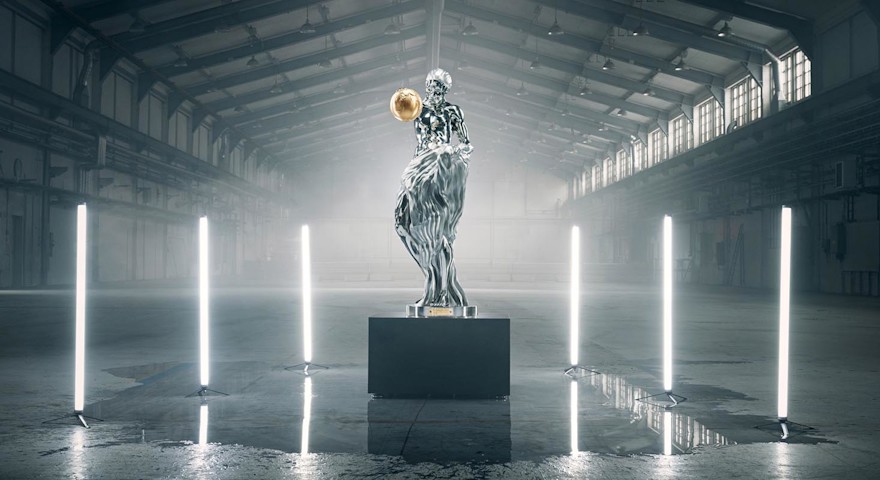STOCKHOLM, Sweden, May 5, 2023 – Sandvik is unveiling the Impossible Statue, a modern masterpiece of engineering created using the latest advances in AI, advanced software solutions and precision manufacturing.

On display at Tekniska Museet (Sweden’s National Museum of Science and Technology), the artwork builds upon the heritage of Michelangelo, Rodin, Kollwitz, Kotaro and Savage, art masters who span three continents and 500 years.
The Impossible Statue was made possible through an innovative use of AI modelling and the latest cutting-edge manufacturing solutions. It is crafted from stainless steel and the complexity and precision required to make the statue a reality put Sandvik’s advanced digital manufacturing solutions and cutting tools to the test.
The high-tech engineering group is a world-leader within component manufacturing due to its unique position with leading offerings of cutting tools and software solutions. These solutions can enable optimized ways for customers to collaborate, design and manufacture products using data insights and modelling.
Sandvik’s world-leading metal cutting tools and expertise are used in a wide range of industries, from aerospace to general engineering, automotive and the medical industry. The tools are used to manufacture components for applications with the highest of quality demands, such as for aerospace engines, medical implants, and electric vehicle components. Sandvik has more than 100,000 direct customers in its metal-cutting tools operations and more than 400,000 manufacturing software licensees installed.
“The Impossible Statue is a great example of what the combination of modern technology and human brilliance can create,” said Peter Skogh, Director at Tekniska museet. “Our mission is to create a broader understanding of the possibilities of technology and to stimulate the next generation to pursue a career within STEM-topics. This project is ticking all the boxes for us and I’m excited to offer our visitors the opportunity to see the statue.”
Making the impossible, possible
The statue was designed by training multiple AI models on the work of five of the world’s greatest and most renowned sculptors, balancing some of their best-known attributes:
- The dynamic off-balance poses of Michelangelo (Italy, 1475-1564)
- The musculature and reflectiveness of Auguste Rodin (France, 1840-1917)
- The expressionist feeling of Käthe Kollwitz (Germany, 1867-1945)
- The focus on momentum and mass exhibited by Takamura Kotaro (Japan, 1883-1956)
- The defiance in the figures of Augusta Savage (USA, 1892-1962).
Following the creation of a 2D design bringing together the styles of these five artists, Sandvik undertook a process of translating this into a complete 3D image. Using depth estimators to build an initial 3D model, human pose-estimators to refine the body, videogame algorithms to generate realistic fabric, and specialized AI to re-introduce fine details that were lost in previous steps, Sandvik was ready to turn the design into reality. By using software from Mastercam, the most widely used CAM (computer-aided manufacturing) brand in the industry, a statue with over 9 million polygons and complex details had been created.
Showcasing the potential of Sandvik’s end-to-end digital capabilities, the manufacturing process was thoroughly tested in simulations before any material was cut. Vericut, Sandvik’s proprietary machining simulation and optimization software ensured safe, reliable and efficient tooling and machining processes was carried out by Sandvik Coromant. Not a single part of the statue had to be scrapped and remade throughout the process as each had been digitally perfected before the start of machining.
Through digital simulation the total time for testing and verifying the process was cut to a sixth of what would have been required in a manual operation. Additionally, twice as much stainless steel would have been required without the digital simulation tool. Thanks to digital solutions for the virtual optimization of tool usage and tool paths there was also a very steep development curve throughout the process, and only three simulations were needed to make the last piece compared to 100 simulations for the first one.
Sandvik opted to machine 17 separate pieces using a wide range of Sandvik Coromant tools for turning, milling and drilling. This was considered a superior method to alternatives due to better surface quality; because of the extremely high precision of the finished work the intersections between the different parts are almost invisible to the naked eye. By sectioning the statue Sandvik was able to reduce the amount of steel required significantly, and all material removed from the original pieces of stainless steel was recycled by Alleima, Sandvik’s materials supplier for the project.
The creation of the statue involved a team of experts in CAD (computer-aided design) modeling, CAM programming and machining. 40 million lines of G-code were generated in the process: code that guided the machining of the different parts in the CNC (computer numerical control) machines used for production. Finally, advanced metrology software from Sandvik-owned Metrologic Group was used to verify the details of the statue.
The final statue weighs 500 kg and stands at 150 cm. It deviates from the digital design by less than 30 microns (0.03 mm), a remarkable feat considering its size and the complexity of the 3D model. This is the same level of precision demanded in, for example, the manufacture of Swiss watches; it was achieved by virtually simulating the optimal way to manufacture the statue, utilizing digital twin technology and technology for optimizing tool paths.
Nadine Crauwels, President at Sandvik Machining Solutions, said: “The manufacturing methods used to make the Impossible Statue are the same we use to create value for our customers every day. With our leading capabilities across digital solutions and physical manufacturing tools, we are in a great position to advance component manufacturing in key global industries, improving efficiency and sustainability by connecting all steps in the full manufacturing process. We decided to manufacture the Impossible Statue to showcase this, and by using all our capabilities we could significantly improve manufacturing efficiency, reduce waste, and ensure the highest quality in each step of the process.”
More information on the Impossible Statue, including downloads of images and videos, can be found at https://www.home.sandvik/statue.
About Sandvik Group
Sandvik is a high-tech and global engineering group offering products and services that enhance customer productivity, profitability and sustainability. We hold world-leading positions in selected areas – tools and tooling systems for metal cutting; equipment and tools, service and technical solutions for the mining industry and rock excavation within the construction industry; products in advanced stainless steels and special alloys as well as products for industrial heating. In 2020, the Group had approximately 37,000 employees and revenues of about 86 billion SEK in more than 160 countries within continuing operations. For more information, visit https://www.home.sandvik/en.






